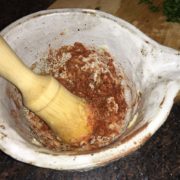Aromas of Cooking Up Portuguese
Aromas of cooking up Portuguese, at times, can be the subject of discussion. Quite often, when are discussing our Portuguese culture, it is said “you could always tell when you enter a Portuguese home.” So what does that mean?
For the younger generation, usually American born, it means visions of plastic coverings on furniture, second kitchens and funny habits. But many Portuguese, and you know who you are, it requires little, if any, explanation. It means an unspoken explanation. A wave of your hand skyward. The mere thought of “aromas” is heady. You know, those wonderful aromas emitting from activity in the kitchen.
Kitchen aromas abound in Portuguese homes, especially when the women are stay-at-home mothers. Even if they work outside the home, when they come home, these mothers and wives prepare dinner.
The aromas, I speak of, are recognizable ones from “refogados” or “ceboladas” (depending on what region). The aromas of cooking up Portuguese food, the simmering pots of onions sautéing in olive oil fill the senses. Sometimes these aromatic bases are enhanced with peeled chopped tomatoes and most definitely garlic. I mean, what Portuguese cook worth their salt doesn’t use an abundance of onions and garlic, potatoes, parsley and/or cilantro and spices like paprika, chili peppers and cumin? Well spiced stews and braises of pork, rabbit, beef, poultry, lamb or seafood have that signature base.
Your senses flood when you first enter a Portuguese home and you get the first whiff. You think, I know I am in a Portuguese home from the aromas, but not just from the kitchen. How about the aromas coming from sardines grilling away in the backyard? Now despite the delicious sardines, that is a distinctive aroma which definitely belongs in the backyard.
Today, though, there are some gaps in aromas of cooking up Portuguese. The amount of distinctive aromas emitting from the kitchen of a Portuguese homes is decreasing. The decrease is due to the aging of our elders, the younger generation are eating out more plus time constraints. Sad to say, there are many of the younger generation that are not interested or can not make the time to learn from their mothers and grandmothers. They are perfectly happy to eat and enjoy their favorite Portuguese dishes when someone else is cooking.
During the holidays for example, when the turkey is roasting and the aroma of my grandmother’s stuffing is in the air, it may just make your mouth water. And you know, it isn’t just knowing you are in a Portuguese home when those aromas are floating around. I can’t quite explain the emotions and memories that transplants my soul in my kitchen. But I can tell you that when I answer my door for my arriving dinner guests, it gives me great pleasure when they exclaim, “Something sure smells good”!
Refogado/Cebolada
Simple as it seems, it is the basis for many stews, braises, and sometimes soups. This can be expanded on to include spices like cumin, cinnamon depending on what you area making.
This an example of the base:
½ olive oil or as needed
1, 2 or more large onions, (depending on what you are making) sliced thinly or thick depending on the length of cooking time- the shorter the time, the thinner the slice or the onions will just melt away if too thin with a lengthily cooking time.
- Heat the olive oil in a pot or skillet and add the onions. Sauté until they are soft and glassy or are lightly golden. To this I would add the following. The amounts are subjective to what I am making on that day.
For example:
1 teaspoon or tablespoon of paprika
¼ -1/2 cup peeled, seeded and chopped tomato
Garlic cloves- fresh garlic is best- to your taste
¼ – cup of white wine or more depending on the dish
1 bay leaf
Chili pepper flakes or hot sauce, to taste
Fresh parsley
Fresh cilantro
Once you have added the seasonings, let it simmer for a few minutes so the ingredients can marry to one another and then the aroma will fill your kitchen and beyond!









